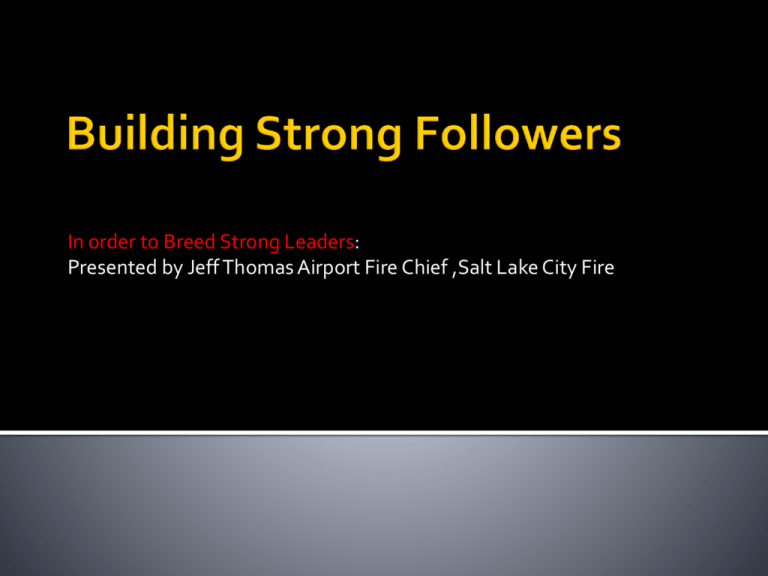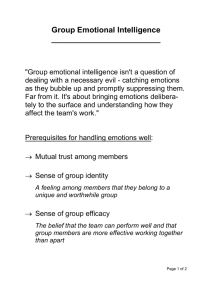Building Strong Followers
advertisement

In order to Breed Strong Leaders: Presented by Jeff Thomas Airport Fire Chief ,Salt Lake City Fire If you want to or not, after all it is your time, I am as flexible as the water. Our Goal: is to identify and share thoughts, best practices associated with mentoring and leading, leaders of tomorrow Objectives: Examine leadership and what exactly does that mean, organizational transparency and communication, open discussion concerning best practices The American Heritage Dictionary defines a follower as: One who subscribes to the teachings or methods of another; adherent.2. A pursuer, An attendant, servant, or subordinate. Generational divides in the work place considers: Baby Boomers, “work, work, work. Its what we are about 1946-64. Gen Xer’s, Enjoy work, but are more concerned about work-life balance, flexibility 1965-1980. Millennials or (Gen Yers) “Work flexibility anywhere but I need complete access to information and the answer to why”, technology driven,1980 and forward. “If I have seen farther than others, it is because I was standing on the shoulder of giants”. Isaac Newton “A leader is a person who has the ability to get other people to do what they don’t want to do, and like it” President Harry Truman “If your actions inspire others to dream more, learn more, do more and become more, you are a leader”. President John Quincy Adams “The leaders who work most effectively, it seems to me, never say "I." And that's not because they have trained themselves not to say "I." They don't think "I." They think "we"; they think "team." They understand their job to be to make the team function. They accept responsibility and don't sidestep it, but "we" gets the credit. This is what creates trust, what enables you to get the task done”. Peter Drucker “The one thing you can’t take away from me is the way I choose to respond to what you do to me. The last of one’s freedoms is to choose ones attitude in any given circumstance.” Victor Frankl “ In order for the one to lead, he/she must understand the needs of the followers, for it is the common interest that motivates and empowers the march forward regardless of the obstacles before you” Leadership attributes: Uncommon communicator that utilizes a medium that the followers are able to understand. Consistently consistent but able to adjust if out of necessity. Trustworthy and a relationship builder. Sixth sense Courage while under fire and an undying support of the team Please provide examples of leaders in the past that we can all identify with? Jesus Christ Mohandas Karamchand Gandhi General George S Patton Marin Luther King Jr President Franklin Delano Roosevelt Caesar Chavez The Profit Muhammad Parents, teachers and spiritual leaders etc. The late Dr. Oliver J Jones said that “the key to creating leaders of tomorrow is all about giving the followers the good stuff.” He would always include the Pygmalion effect as a way to provide a transformation. Can someone provide a description of the Pygmalion effect? People tend to live up to what's expected of them and they tend to do better when treated as if they are capable of success. These are the lessons of The Pygmalion Effect. George Barnard Shaw wrote a play, entitled Pygmalion, about Henry Higgins (the gentleman) and Lisa Doolittle (the cockney flower girl whom Henry turns bets he can turn into a lady). Treat a man as he is and he will remain as he is. Treat a man as he can and should be and he will become as he can and should be. Goethe Victor Frankl’s book “Mans Search For Meaning”, he said that you must support the subject to an even higher position than he/she could be but rather to the level where he/she should be. If you have an even perspective you will fall short of expectations. You should aim higher than the subject can imagine and therefore end at the level that you want for the desired outcome. Now that we have started to provide the positive reinforcement how can we influence the middle of the road performer. We have a tendency to create the star’s of our organizations through the Pygmalion effect from day one. What can we do to influence the followers of tomorrow? How does the fledgling follower (needs improvement, meets standards, exceed standards) transform to becoming a leader. He/she must consider how they fit into the team and the support needed to accomplish the goal. In terms of understanding leadership we must examine how the leaders of tomorrow need to comprehend how to avoid pitfalls. “The Five Dysfunctions of a Team” by Patrick Lencioni will be discussed. Leadership and the follower The first dysfunction is an Absence of Trust among team members. Essentially, this stems from their unwillingness to be vulnerable within the group. Team members who are not genuinely open with one another about their mistakes and weaknesses make it impossible to build a foundation for trust. Leadership and the follower This failure to build trust is damaging because it sets the tone for the second dysfunction “Fear of Conflict”. Teams that lack trust are incapable of engaging in unfiltered and passionate debate of ideas. Instead, they resort to veiled discussion and guarded comments. Leadership and the follower A lack of healthy conflict is a problem because it ensures the third dysfunction of a team : “Lack of Commitment. “ Without having aired their opinions in the course of passionate and open debate, team members rarely, if ever, buy in and commit to decisions, though they may feign agreement during meetings. Leadership and the follower Because of this lack of real commitment and buy- in, team members develop an “Avoidance of Accountability”, the fourth dysfunction. Without committing to a clear plan of action, even the most focused and driven people often hesitate to call their peers on actions and behavior that seem counterproductive to the good of the team. Leadership and the follower Failure to hold one another accountable creates an environment where the fifth dysfunction can thrive. Inattention to Results occurs when team members put their individual needs (such as ego, career development, or recognition) or even the needs of their division above the collective goals of the team. We as current leaders have an obligation to posses the attributes that I listed on the earlier slides. You must always be seen as above board in all of your actions We must avoid the pitfalls and the five dysfunctions I use the T.V. screen as my moral compass Don’t shrink from the challenging employee scenario, you will become stronger as a result of your efforts and experience Never engage in the “gotcha” game. Catch your people doing the right thing and acknowledge them for it, positive reinforcement. Always set up your followers and superiors up for success, this example is one of selfless behavior. Be quick to give others credit and make sure that the person that can carry the water receives the information behind the scene. Getting out of the “box". Do you have a tendency to treat people as people or objects? If you could spend a day with any three people through out all time and history, who would they be and why? Take a couple of minutes and write it down. I can almost guarantee that the people that you picked possessed an uncommon leadership skill. Current leaders should consider the Japanese philosophy Kaizen or constant improvement. Harvard business review: The Toyota model, the management and leadership connection. Coach John Wooden identified the three B’s of leadership as: Be slow to criticize and quick to commend Be more concerned with what you can do for others than what they can do for you Be more concerned with getting ahead instead of getting even EQ: The emotionally intelligent know themselves. They know their strengths and weaknesses. Goals and fears, hot buttons and emotional bare wires. They recognize their emotions, and they use that knowledge to succeed. The EQ concept argues that IQ, or conventional intelligence, is too narrow; that there are wider areas of Emotional Intelligence that dictate and enable how successful we are. Success requires more than IQ (Intelligence Quotient), which has tended to be the traditional measure of intelligence, ignoring essential behavioral and character elements. We've all met people who are academically brilliant and yet are socially and inter-personally inept. And we know that despite possessing a high IQ rating, success does not automatically follow. Emotional Intelligence - two aspects This is the essential premise of EQ: to be successful requires the effective awareness, control and management of one's own emotions, and those of other people. EQ embraces two aspects of intelligence: Understanding yourself, your goals, intentions, responses, behavior and all. Understanding others, and their feelings. Emotional Intelligence - the five domains Knowing your emotions. Managing your own emotions. Motivating yourself. Recognizing and understanding other people's emotions. Managing relationships, ie., managing the emotions of others. Paving the way assessing the organization's needs assessing the individual delivering assessments with care maximizing learning choice encouraging participation linking goals and personal values adjusting individual expectations assessing readiness and motivation for EQ development Doing the work of change foster relationships self-directed change and learning setting goals breaking goals down into achievable steps providing opportunities for practice give feedback using experiential methods build in support use models and examples encourage insight and self-awareness Encourage transfer and maintenance of change (sustainable change) encourage application of new learning in jobs develop organizational culture that supports learning Big Picture Remember that we all begin the same way Approximately 7 lbs., 20 inches long, slippery and crying Where we go from there is up to us Now Lead! Thank you!





